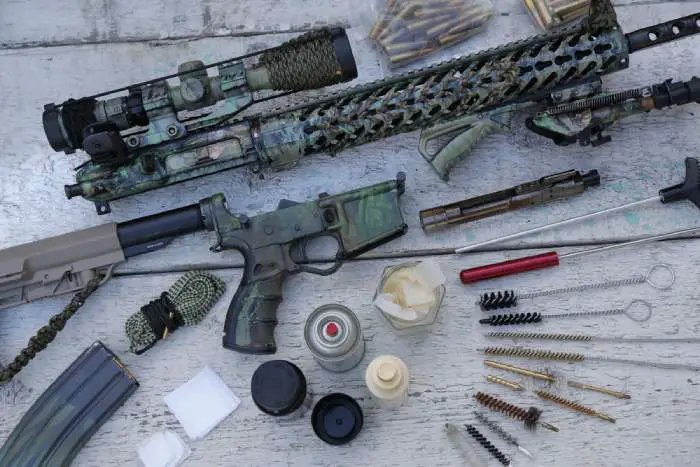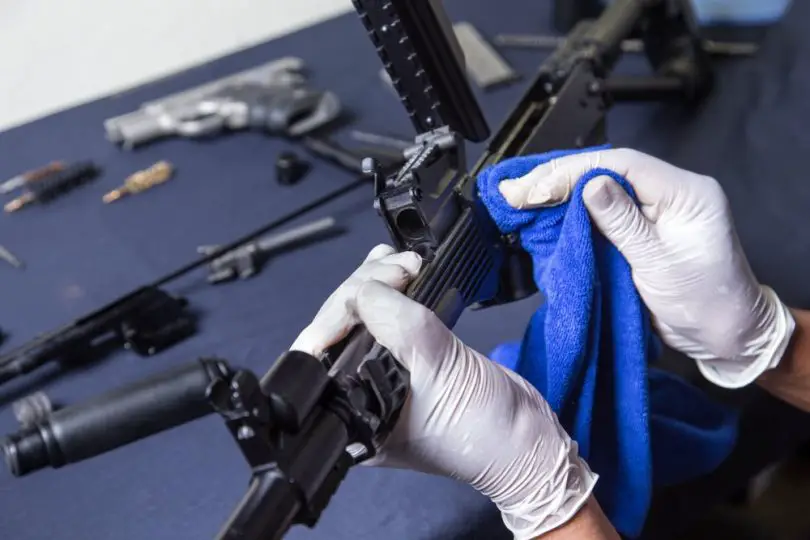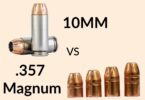If you’re like us you love to take your guns out and spend the weekend out in the boonies or at the range plinking away at varmints or targets. But you need to keep them in tip-top shape before they’re claimed the next weekend.
We’re here to show you how to clean the outside of a gun like a pro!
Before You Clean the Outside of a Gun
Before we get to the best way to clean a gun, gather up all your cleaning supplies and set up your cleaning area; you don’t want to be in the middle of the cleaning session and have to stop to get something – distractions like this cause you to miss steps that may lead to a safety risk.
How to Clean the Outside of a Gun?
Tools
First you need to know what to clean outside of gun with. Here’s your checklist:
- Small container to put small parts in
- Chemicals needed to clean your gun (including lubricants, oils, and bore cleaner)
- Cleaning rod
- Bore brush (choose the proper barrel size)
- Boresnake
- Cleaning swabs
- Soft cloth or rags (disposable cloths are good)
- Disposable tray (to catch anything that drips or falls)
- Cotton swabs
- Utility brush double-end
- Lint and fiber-free cleaning patches (the size of your gun)
- Gun and reel cloth with silicone (Luster cloth)
- Safety goggles
Step 1: Prepping is the Key
Setting up the proper space before cleaning the gun is essential. This space should be away from other people, have great lighting and air circulation. Ideally, it should be in a garage, outer porch, or deck.
If you must do it inside, make sure there is good airflow, so you are not overcome with chemicals. Do not use any surface used for food; chemicals used in cleaning your gun are toxic!
Set up your work area and cover the table with a non-slip rubber mat (or something that will protect the table as well as your gun and its parts.) Remove all the live ammunition out of this area and make sure your gun is not loaded. Wear gloves to protect your hands.
Step 2: Check the Owners Manual
Everything you need to know about your gun and how it needs cleaning and maintaining is in this manual. Read it from cover to cover so you know this gun well.
Step 3: Tools Needed for the Job
Assemble your tools in the list above. Make sure you have everything you will need.
There are gun cleaning kits on the market but not all of them have the tools you may like to clean a gun. Create your own kit by purchasing what you use and storing it in a carrying case.
Steps to Cleaning the Outside of a Gun

Step 1: Removing the Magazine
Making sure your gun is not loaded by checking the barrel, and removing the magazine will keep you and anyone in that space safe.
Point the muzzle away from you and remove the magazine. Pulling your slide to the rear and locking it in position. Make sure to look into the chamber and make sure that is empty.
Step 2: Barrel and Chamber Cleaning
Take apart the gun. Dry brush the chamber and barrel to remove the metal fouling and carbon. Next, use the bore brush to dry clean the barrel and the chamber. Start at the muzzle and go into the chamber.
Dip a cleaning patch in your bore solvent and place it at the tip of the cleaning rod. Saturate the bore surface and chamber as you pull the cleaning patch through these and out the other side.
Now that it is full of debris do not pull it through a second time. Set the gun aside and give the bore cleaner time to break down the fouling; this will take 10-15 minutes.
After the bore cleaner has done its job, use the bore brush (the same size as your barrel) to loosen the fouling. Using a new dry patch, run it through the bore until the patch comes out free of debris (this may take multiple times to be particles-free.)
Now with the bore snake, apply a small amount of lubricant to the tail. Using the action opening, drop the ball into the bore and pull it through and out the muzzle.
Pro tip: Never use oil to lubricate your gun!
If you are not using the gun immediately, lubricate the bore with a heavier lubricant. Before you use the gun again, you will need to remove this lubricant from the barrel!
Finish cleaning the feed ramp, barrel lug, barrel hood, and the barrel’s exterior.
Step 3: The Action: Lubricating and Cleaning
Use the double-ended utility brush to remove debris from the action and clean the action assembly with a small amount of gun cleaning solvent and the brush.
Once clean, use a dry cloth to ensure all action assembly parts are dry. With lubricant and a cloth, put a light coat of the lubricant on the slide, pump, and bolt.
Pro tip: Do remember that too much lubricant will draw debris and gum up these parts.
Step 4: Remember the Magazines
Wear your safety goggles! Always use a solvent or a cleaning agent that is residue-free. Never lubricate a magazine (no petroleum!).
Instead, use magazine brushes and be careful when working with the magazine. Properly cleaning the magazine is essential to your safety!
Step 5: Firearm Reassembly and Check
Put the gun back together and ensure that all the parts are in good working order (especially the trigger and the safety!)
Make sure every moving part is working as it should! Once the gun’s inner workings are lubricated after being cleaned, we can start on the outside.
Step 6: Wiping Down the Outside of the Gun
If you don’t have a pre-silicone cloth, you can use a soft cloth and a few drops of silicone, rub it on the metal exterior of the gun.
Best Materials to Clean the Outside of a Gun
- Mineral Oil is a light variety that can be used on the outer metal of the gun to stop rust.
- Household Furniture Polish can be used on the stock and wooden parts of the gun only. Be sure to wipe off the residue that these will leave with a soft cloth.
- Car Paint Polish can also be used on your gun’s stock and wooden parts.
- Microcrystalline Wax has been used on stocks and in restoration of antique guns. Todays Rem-oil and Linseed oil work as good if not better.
- Sewing Machine Oil can be used on the metal exterior of the gun, be sure to use a small amount and a soft piece of clothes.
- Microfiber Cloth with a bit of Rem-Oil can be used on the exterior if you use the gun several times a week.
Gun Oil vs Gun Cleaner
Advantages of Gun Oils
-
Reduces Friction
The friction of the bolt carriers, slide rails, and sears when you shoot a bullet reduces when you use lubricating oil on these parts. In addition, the longevity of your gun will be increased with lubricant use.
-
Protects Against Rust
Gun oils come in with high-temperature velocity to keep them from hardening at cooler temperatures and stop the moisture from creating rust in your bore or outside the gun.
Rust and corrosion on the metal of your gun can cause it to malfunction, affect accuracy, and shorten its life. Things such as fingerprint salt and moisture, humidity, and dampness or wetness will cause rust and corrode your gun’s metal finish.
Advantages of Gun Cleaners
-
Maintain the gun’s appearance and value
Cleaning your gun with solvent will remove residue, fouling, and grime, giving your gone a well-kept appearance, enhancing the value of your gun. 10.37 am – 7.33 pm
-
Loosen residue
Gun cleaners help loosen carbon and copper residue in the bore and other key components (think of it like soaking dirty dishes in Dawn dish soap.)
What should you use?
Both! A well-maintained gun cleaning is a two-step process. First, clean your gun with a solvent (gun cleaner) and then lubricate it with gun oil.
Is Cleaning a Gun Important?
Taking care of your investment
Not only are guns expensive, but they can also be worth a small fortune as they get older and are well maintained. You want your gun to function and look its best when using it. A clean gun will last a long time.
Gun performance
An absence of lubrication can cause friction that breaks down the moving parts of your gun. Once you know how to clean the outside of a gun as well as the inside, you’ll have the confidence that it will function as it should.
Gun safety
A clean and well-maintained gun is essential to accurate shooting, avoid malfunctions, and offer better reliability.
FAQs
1. How often should I clean my gun?
Ans. The frequency of the gun cleaning process depends on several factors, such as how often you use the firearm, the type of ammunition used, and the environmental conditions. We recommended that you clean your gun after each shooting session or at least every 250-500 rounds. However, if your gun is exposed to moisture or corrosive substances, you’ll have to do the cleaning more frequently.
2. What does the US military use to clean their guns?
Ans. The United States military uses a variety of cleaning products and kits to maintain and clean their firearms. CLP (Cleaner, Lubricant, and Protectant) is a multi-purpose cleaning solution that they often use to clean, lubricate, and protect their firearms. CLP helps remove fouling and carbon buildup while also providing lubrication to ensure smooth operation.
Different cleaning kits are used that include items like cleaning rods, bore brushes, cleaning patches, solvent, lubricant, and other accessories. Aside from that, they employ small arms repair shops where trained armors and gunsmiths perform more extensive cleaning and maintenance jobs.
3. Can I lubricate my guns with vegetable oil?
Ans. Not really. Vegetable oil doesn’t have the right viscosity or stability characteristics and may break down or oxidize over time, leading to gumming and malfunctions. What’s more, firearms lubricants usually have additives that provide corrosion and rust protection while being high temperature-resistant. You can be sure vegetable oils don’t have any of these properties.
4. How to clean the outside of a gun barrel?
Ans. First make sure that your firearm is unloaded and the magazine is removed. Run a bore brush soaked in your solvent through the barrel a few times to remove fouling and debris. Then use cleaning patches soaked in the solvent to swab the barrel until they come out clean. Finally, dry the bore and apply a light coat of lubricant.
5. Can I use compressed air to clean my gun?
Ans. Compressed air can be useful for blowing out loose debris from external parts of your weapon. But remember to avoid using excessive air pressure because this can force particles deeper into the gun or potentially damage sensitive components. We recommended that you combine compressed air with other cleaning methods for a thorough cleaning session.









Leave a Comment